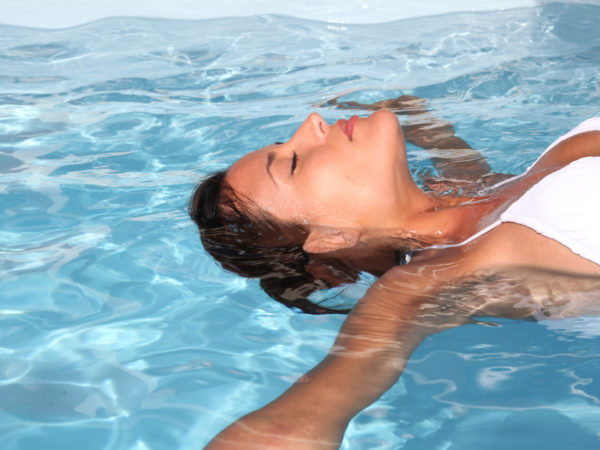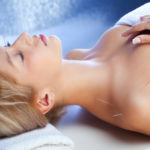Watsu

What is Watsu?
Watsu is a unique form of bodywork that combines immersing the body in warm water with traditional Shiatsu massage. Watsu was created by California-based Shiatsu teacher Harold Dull. In the early 1980s, Dull began developing Watsu techniques while practicing on his massage students at Harbin Hot Springs, about two hours north of San Francisco. In the years since, Dull has continued to practice Watsu as well as teach it to others. He established and is the president of the Worldwide Aquatic Bodywork Association (WABA), which oversees the training of Watsu practitioners around the world.
What is Watsu used for?
The working premise of Watsu is that water takes weight off the vertebrae so they can be manipulated more easily. Watsu is also said to help decrease muscle tension and promote a deep state of relaxation. It has been shown to increase mobility and flexibility, decrease stress, reduce pain and promote better sleep. Health concerns that have been successfully treated by Watsu include injury to the spinal cord or brain through trauma, stroke, or a degenerative condition such as Parkinson’s Disease; arthritis, back and neck pain, fibromyalgia and other chronic pain states; and mood disorders such as generalized anxiety and post-traumatic stress disorder. Watsu has also benefited patients who have undergone surgery and have subsequently developed post-operative pain or limited range of motion.
What should one expect on a visit to a practitioner of Watsu?
A typical Watsu session is performed in water that is 92 to 94 degrees Fahrenheit, and involves a series of movements that the practitioner performs with one hand as he or she balances the recipient with the other. Expect to be gently rocked, stretched, turned, bent and arched.
Being held and manipulated while floating in water can be a profound experience. Deep states of relaxation can be achieved, especially if a level of connection and trust is reached between patient and practitioner. Watsu practitioners are trained to simply “be” with someone as they experience this kind of emotional response. Watsu advocates say that by the end of a session, the state of deep relaxation and harmony, along with the connection felt during Watsu, can create a transformational opportunity for clients to deal with their issues.
Are there any side effects or indications where Watsu should be avoided?
Any condition that might be compromised due to floating for a period of time in warm water should be reviewed and evaluated by both patient and practitioner. Medical personnel should be contacted if there is any question or concern prior to undergoing therapy.
Patients with active fever or temperature instability should not undergo Watsu. Individuals with perforated ear drums should also stay out of the water unless they wear medically approved earplugs.
Spinal cord injuries and other neurologically compromised patients need extra supervision and medical clearance. Some of these individuals may have an absent cough reflex (dangerous in situations where water might be inhaled), limited lung capacity, a reduced seizure threshold and impaired sensation. Extra care should be observed when they are in the pool. In addition, any client who has an increased sensitivity to chemicals such as chlorine or bromine should be cautioned, as should those people with epilepsy or multiple sclerosis. These individuals may be extra sensitive to flashing lights (the sun reflecting on the water’s surface) or being overheated. Extra precautions, such as wearing sunglasses or cooling down the pool water, should be taken.
Typically those patients with medical appliances such as intravenous lines, catheters or colostomies can enter the pool as long as certain protective measures are taken.
Individuals with blood clots, cardiac failure or unstable angina should not enter the pool, nor should those patients with active skin infections or those who may be particularly susceptible to acquiring a skin infection. Uncontrolled diabetes or kidney problems, where blood sugar or volume losses can result in cardiovascular problems, should not consider water therapy until their conditions are stabilized.
Is there a governing body that oversees or credentials practioners in Watsu?
The Worldwide Aquatic Bodywork Association (WABA) is an educational non-profit corporation that oversees the training programs for Watsu practitioners as well as establishes guidelines for certification. It authorizes Aquatic Bodywork courses, programs, providers, practitioners and instructors and maintains their authorizations and transcripts. There are core requirements specified by the WABA, with additional requirements based on state and local laws.
WABA specifies training in massage techniques such as Shiatsu or Tantsu in addition to the 16-hour basic course and the three 50-hour courses that prepare the Watsu professional. A total of 500 hours of WABA-approved classes and supervised sessions are required for full certification.
How does one get in touch with a practitioner of Watsu?
Watsu is offered at spas nationwide and in certain integrative treatment centers as a form of physical therapy. The WABA maintains a registry of individuals around the world who have completed the requirements to be registered as a Watsu practitioner. Those who are currently registered, and have completed WABA’s continuing education requirements (50 additional hours of Aquatic Bodywork every 3 years), may choose to promote themselves to the public as a Watsu Practitioner.
Are there other alternative therapies that might work well in conjunction with Watsu?
Virtually any therapy that addresses pain can work well with Watsu. Movement therapies like yoga, tai chi or qigong can be helpful additions. Acupuncture, manipulation and massage can all be therapies that facilitate healing from chronic pain. Because Watsu can induce an altered state of consciousness, using mind-body approaches to simulate the experience can be a helpful reminder of the lessons achieved in a particular session.
How does Dr. Weil feel about Watsu?
Dr. Weil has received the therapy many times and often recommends it.
While other bodywork modalities are based on touch in a stationary, two-dimensional world, Watsu offers a different experience. A three-dimensional environment, nearly free from gravity, within a warm and comforting fluid-space and the opportunity to connect with another person all have obvious therapeutic potential.
Achieving states of deep relaxation combined with the therapeutic benefits of good massage therapy can be of great benefit in controlling pain, relieving stress, and recovering from emotional and physical trauma.









